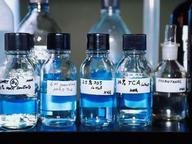Quiz Answer Key and Fun Facts
1. According to the Brønsted-Lowry theory of proton transfer, an acid is a donor of protons, while a base is an acceptor of protons.
2. What would be the conjugate base of the conjugate base of sulfuric acid (H2SO4)?
3. Water can act both as an acid or a base according to Brønsted-Lowry theory, either giving out or taking a proton. What are such substances also known to be?
4. At conditions of Standard Temperature and Pressure, how much does the pH and pOH of a substance add up to?
5. The pH of water at 373 K (boiling point) is 6.14. This means that water has turned acidic.
6. When an acid has reacted with a carbonate, which of the following are you probably NOT going to get back as a PRODUCT?
7. What is the difference between the pH levels of a strong acid and a strong base both at a concentration of 10 moles per liter?
8. You have nitric acid at the concentration of 10^-8 moles per liter. What is going to be its pH level?
9. You have two solutions with equal volumes and equal concentrations of ethanoic acid and sulfuric acid. If you would like to know which one's which, which of the following is the most appropriate method?
10. What pH range would you expect rainwater (without pollution) to lie in?
Source: Author
pokho
This quiz was reviewed by FunTrivia editor
rossian before going online.
Any errors found in FunTrivia content are routinely corrected through our feedback system.
